The Smart Sprinkler Controller Market is estimated to be valued at USD 1.3 billion in 2025 and is projected to reach USD 2.9 billion by 2035, registering a compound annual growth rate (CAGR) of 8.5% over the forecast period.
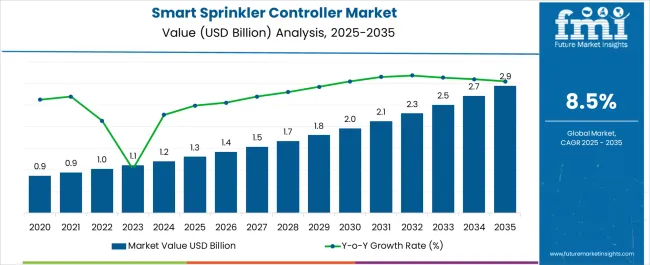
| Metric | Value |
|---|---|
| Smart Sprinkler Controller Market Estimated Value in (2025 E) | USD 1.3 billion |
| Smart Sprinkler Controller Market Forecast Value in (2035 F) | USD 2.9 billion |
| Forecast CAGR (2025 to 2035) | 8.5% |
The Smart Sprinkler Controller market is experiencing significant growth, driven by increasing adoption of automated irrigation solutions across agricultural and residential applications. Rising demand for efficient water management, coupled with growing concerns about resource conservation, is creating strong market momentum. Smart sprinkler controllers enable precise irrigation scheduling, soil moisture monitoring, and remote management through mobile applications, improving crop yields while reducing water wastage.
The integration of IoT technology, sensors, and cloud-based platforms enhances data-driven decision-making, operational efficiency, and sustainability. Government initiatives and incentives for water conservation, along with the need for modernized agricultural infrastructure, are further supporting market expansion. Adoption is being reinforced by advancements in connectivity, ease of installation, and compatibility with a wide range of irrigation systems.
As farmers and agricultural enterprises increasingly prioritize productivity and resource efficiency, the market is poised for sustained growth Continuous innovation in sensor technology, AI-driven scheduling, and remote monitoring capabilities is expected to create further opportunities for market players over the coming years.
The smart sprinkler controller market is segmented by component, application, and geographic regions. By component, smart sprinkler controller market is divided into Hardware and Software. In terms of application, smart sprinkler controller market is classified into Agriculture and Non-Agriculture. Regionally, the smart sprinkler controller industry is classified into North America, Latin America, Western Europe, Eastern Europe, Balkan & Baltic Countries, Russia & Belarus, Central Asia, East Asia, South Asia & Pacific, and the Middle East & Africa.
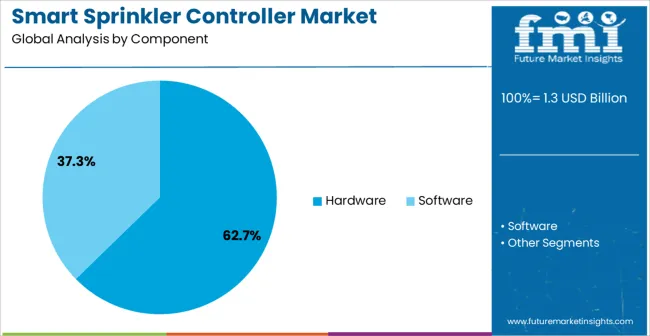
The hardware component segment is projected to hold 62.7% of the market revenue in 2025, establishing it as the leading component type. Growth in this segment is being driven by the increasing demand for durable, reliable, and technologically advanced controllers that can support complex irrigation systems. Hardware devices include controllers, sensors, and connectivity modules that enable real-time monitoring and automation of irrigation schedules.
These devices provide precision in water distribution, ensuring optimal usage while minimizing waste and operational costs. The compatibility of hardware with cloud-based platforms and IoT infrastructure enhances their value for large-scale agricultural deployments.
Continuous improvements in durability, energy efficiency, and ease of installation have strengthened adoption across farms and commercial agricultural facilities As stakeholders increasingly focus on sustainability and resource optimization, hardware components are expected to maintain their market leadership, supported by ongoing technological innovation and rising awareness of smart irrigation benefits.
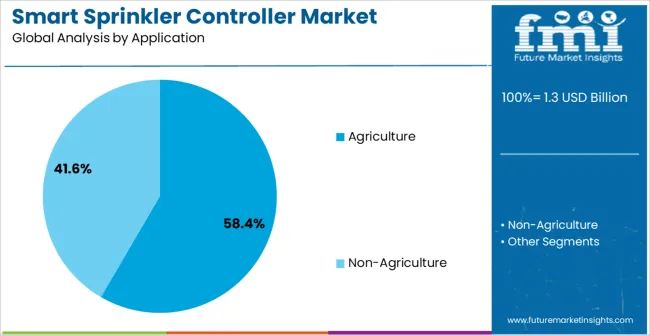
The agriculture application segment is anticipated to account for 58.4% of the market revenue in 2025, making it the leading application area. Growth is being driven by the increasing need for efficient water management to support crop health, yield optimization, and sustainability objectives. Smart sprinkler controllers enable precise irrigation tailored to crop type, soil moisture levels, and weather conditions, significantly reducing water wastage.
The integration of AI-based scheduling, IoT sensors, and remote management platforms allows farmers to monitor and control irrigation operations in real-time. Government incentives for water conservation and precision agriculture initiatives further reinforce adoption in the agricultural sector. These solutions help optimize operational efficiency, reduce labor requirements, and improve farm productivity.
As global demand for food production rises and resource efficiency becomes more critical, the agriculture segment is expected to remain the primary driver of market growth Continuous innovation in smart irrigation technology and data-driven agriculture is anticipated to further enhance adoption rates.
Growing interest on reducing the irrigation expenditure is the key factor contributes the growth of global smart sprinkler controller market. Smart sprinkler controller is an automated water system sprinkles water based on plats requirement without any human intervention.
Smart sprinkler controller is connected to internet through Wi Fi or cable, adjusts the watering schedule based local weather data. Smart sprinkler controller delivers various advantage, including environmental sustainability, reduced labour cost, and also lowers the expense of water usage.
Smart sprinkler controller utilizes adaptive algorithms to automatically determine the optimal watering schedule and adjusts watering cycles, duration and frequency. Also, smart sprinkler controller can be integrated with various home automation platforms including Google assistant, Nest, Amazon Alexa and more, provides full control over the sprinkler through smartphone.
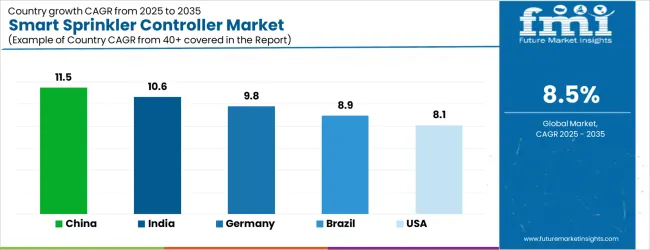
| Country | CAGR |
|---|---|
| China | 11.5% |
| India | 10.6% |
| Germany | 9.8% |
| Brazil | 8.9% |
| USA | 8.1% |
| UK | 7.2% |
| Japan | 6.4% |
The Smart Sprinkler Controller Market is expected to register a CAGR of 8.5% during the forecast period, exhibiting varied country level momentum. China leads with the highest CAGR of 11.5%, followed by India at 10.6%. Developed markets such as Germany, France, and the UK continue to expand steadily, while the USA is likely to grow at consistent rates. Japan posts the lowest CAGR at 6.4%, yet still underscores a broadly positive trajectory for the global Smart Sprinkler Controller Market. In 2024, Germany held a dominant revenue in the Western Europe market and is expected to grow with a CAGR of 9.8%. The USA Smart Sprinkler Controller Market is estimated to be valued at USD 470.9 million in 2025 and is anticipated to reach a valuation of USD 470.9 million by 2035. Sales are projected to rise at a CAGR of 0.0% over the forecast period between 2025 and 2035. While Japan and South Korea markets are estimated to be valued at USD 71.1 million and USD 40.8 million respectively in 2025.
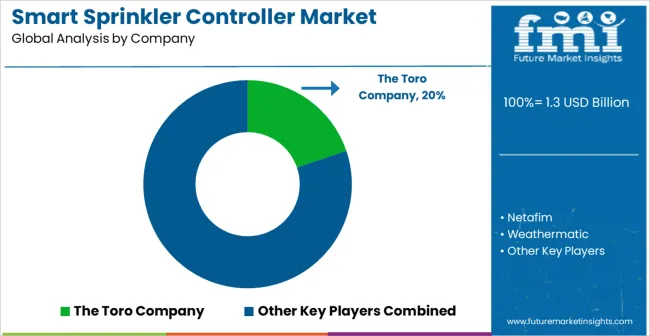
| Item | Value |
|---|---|
| Quantitative Units | USD 1.3 Billion |
| Component | Hardware and Software |
| Application | Agriculture and Non-Agriculture |
| Regions Covered | North America, Europe, Asia-Pacific, Latin America, Middle East & Africa |
| Country Covered | United States, Canada, Germany, France, United Kingdom, China, Japan, India, Brazil, South Africa |
| Key Companies Profiled | The Toro Company, Netafim, Weathermatic, Hunter Industries, Rain Bird Corporation, Galcon, Orbit Irrigation Products, Hydropoint Data Systems, Calsense, Scotts Miracle-Gro, and Skydrop |
The global smart sprinkler controller market is estimated to be valued at USD 1.3 billion in 2025.
The market size for the smart sprinkler controller market is projected to reach USD 2.9 billion by 2035.
The smart sprinkler controller market is expected to grow at a 8.5% CAGR between 2025 and 2035.
The key product types in smart sprinkler controller market are hardware and software.
In terms of application, agriculture segment to command 58.4% share in the smart sprinkler controller market in 2025.






Our Research Products

The "Full Research Suite" delivers actionable market intel, deep dives on markets or technologies, so clients act faster, cut risk, and unlock growth.

The Leaderboard benchmarks and ranks top vendors, classifying them as Established Leaders, Leading Challengers, or Disruptors & Challengers.

Locates where complements amplify value and substitutes erode it, forecasting net impact by horizon

We deliver granular, decision-grade intel: market sizing, 5-year forecasts, pricing, adoption, usage, revenue, and operational KPIs—plus competitor tracking, regulation, and value chains—across 60 countries broadly.

Spot the shifts before they hit your P&L. We track inflection points, adoption curves, pricing moves, and ecosystem plays to show where demand is heading, why it is changing, and what to do next across high-growth markets and disruptive tech

Real-time reads of user behavior. We track shifting priorities, perceptions of today’s and next-gen services, and provider experience, then pace how fast tech moves from trial to adoption, blending buyer, consumer, and channel inputs with social signals (#WhySwitch, #UX).

Partner with our analyst team to build a custom report designed around your business priorities. From analysing market trends to assessing competitors or crafting bespoke datasets, we tailor insights to your needs.
Supplier Intelligence
Discovery & Profiling
Capacity & Footprint
Performance & Risk
Compliance & Governance
Commercial Readiness
Who Supplies Whom
Scorecards & Shortlists
Playbooks & Docs
Category Intelligence
Definition & Scope
Demand & Use Cases
Cost Drivers
Market Structure
Supply Chain Map
Trade & Policy
Operating Norms
Deliverables
Buyer Intelligence
Account Basics
Spend & Scope
Procurement Model
Vendor Requirements
Terms & Policies
Entry Strategy
Pain Points & Triggers
Outputs
Pricing Analysis
Benchmarks
Trends
Should-Cost
Indexation
Landed Cost
Commercial Terms
Deliverables
Brand Analysis
Positioning & Value Prop
Share & Presence
Customer Evidence
Go-to-Market
Digital & Reputation
Compliance & Trust
KPIs & Gaps
Outputs
Full Research Suite comprises of:
Market outlook & trends analysis
Interviews & case studies
Strategic recommendations
Vendor profiles & capabilities analysis
5-year forecasts
8 regions and 60+ country-level data splits
Market segment data splits
12 months of continuous data updates
DELIVERED AS:
PDF EXCEL ONLINE
Smart Home Water Sensors & Controllers Market Trends & Forecast 2025 to 2035
Non-Agriculture Smart Irrigation Controllers Market Size and Share Forecast Outlook 2025 to 2035
Smart Meeting Pod Market Size and Share Forecast Outlook 2025 to 2035
Smart Electrogastrogram Recorder Market Size and Share Forecast Outlook 2025 to 2035
Smart Aerial Work Robots Market Size and Share Forecast Outlook 2025 to 2035
Smart Bladder Scanner Market Size and Share Forecast Outlook 2025 to 2035
Smart School Bus Platform Market Size and Share Forecast Outlook 2025 to 2035
Smart Home Wireless Smoke Detector Market Size and Share Forecast Outlook 2025 to 2035
Smart Bus Platform Market Size and Share Forecast Outlook 2025 to 2035
Smart Vision Processing Chips Market Size and Share Forecast Outlook 2025 to 2035
Smart Touch Screen Scale Market Size and Share Forecast Outlook 2025 to 2035
Smart Magnetic Drive Conveyor System Market Size and Share Forecast Outlook 2025 to 2035
Smart Wheelchair market Size and Share Forecast Outlook 2025 to 2035
Smart Mining Technologies Market Size and Share Forecast Outlook 2025 to 2035
Smart Parking Market Size and Share Forecast Outlook 2025 to 2035
Smart Digital Valve Positioner Market Forecast and Outlook 2025 to 2035
Smart Card IC Market Size and Share Forecast Outlook 2025 to 2035
Smart-Tag Inlay Inserters Market Analysis - Size and Share Forecast Outlook 2025 to 2035
Smart TV Market Forecast and Outlook 2025 to 2035
Smart/AI Toy Market Size and Share Forecast Outlook 2025 to 2035

Thank you!
You will receive an email from our Business Development Manager. Please be sure to check your SPAM/JUNK folder too.
Chat With
MaRIA